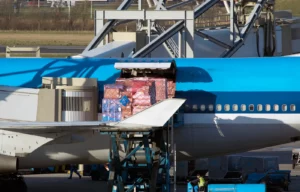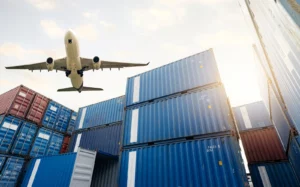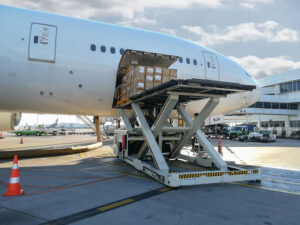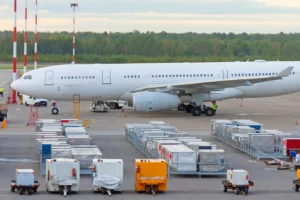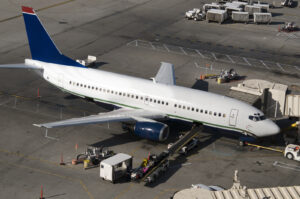
Air freight rates on the rise ahead of traditional peak season – as AI drives markets
Global air freight rates rose strongly in October according to the latest data from TAC Index. The Baltic Air Freight Index (BAI00) gained a solid +7.6% over four weeks to November 3, leaving it not far below where it was 12 months earlier at -4.6% year-on-year. The latest data is not bad news for air cargo carriers after 12 months in which jet fuel prices were down a similar amount – about -2.6% YoY at end-October according to Platts data. That indicates profit margins should be close to last year’s healthy levels. Superficially, the numbers also look consistent with the beginnings of a typical peak season surge – which usually runs through to Thanksgiving on US lanes and on until Christmas in Europe. The numbers for the busiest lanes by volume out of China appear to support this normal seasonal profile. The index of outbound routes from Hong Kong (BAI30) gained +5.8% over four weeks to November 3, leaving it down only -4.5% YoY. Outbound Shanghai (BAI80) gained some +16.6% month-on-month, to leave it lower only -2.3% YoY. A closer look at the new Baltic Air Freight Spot (BAI Spot1) indices out of Hong Kong – now officially launched in partnership with TAC Innovation, and extended to include routes originating from India and Korea too – appear to confirm these trends in greater detail. BAI Spot from HK to Europe (which had already risen significantly in September) edged up only a little further from HK$36.21 per kilo on September 30 to HK$37.91 on October 31. But BAI Spot rates from HK to the US rose much more strongly during October – in line with a typical peak season trend, which sees rates rise fastest on Transpacific routes first and not until later on Asia-Europe lanes. HK to East Coast spot rates jumped from HK$37.85 per kilo on September 30 to HK$44.46 on October 31. HK to West Coast rose from HK$36.85 to HK$41.36. Rates out of Europe were also firming up in October, particularly on Transatlantic lanes – leaving them up close to +25% in dollar terms YoY. The index of outbound routes from Frankfurt (BAI20) gained +18.7% MoM to push it back into positive territory by +1.3% YoY. By contrast, outbound London Heathrow (BAI40) – which had gained significant ground in recent months – fell back sharply towards month-end to finish at -19.3% MoM and at -13.3% YoY. Rates from the US also continued to be softer than from elsewhere. The index of outbound routes from Chicago (BAI50) slipped another -1.5% MoM to leave it still languishing at -15.3% YoY – close to its lowest points of the past five years. Although recent numbers look consistent with the start of a typical peak season surge, sources continue to be cautious about how big a peak there will be this year for various reasons. For one thing, we will be comparing with very pronounced peak season spikes in both 2023 and 2024 – when rates shot dizzyingly high out of Hong Kong in particular through November and early December. Last year, demand was also elevated by a massive boom in e-commerce business. In 2025 that has been curtailed, at least on Transpacific routes, by the end of the de minimis exemption for small packages into the US – as well as higher tariffs (if nothing like so high as feared). As a consequence, some capacity has shifted from Transpac to China-Europe routes – as well as to other lanes from Asia, such as from Vietnam and Thailand, and from Taiwan to the US, boosted by surging trade in semiconductors and related equipment. BAI Spot rates out of Seoul in South Korea have also been rising in recent weeks. Despite the shifting patterns, it seems overall volume has remained close to or even a little above last year’s high levels – leading some observers to remark that fears of rampant ‘de-globalisation’ appear somewhat exaggerated. All this also indicates there should be a peak season spike again this year – though questionable how high it will go, and on which lanes most noticeable. Meanwhile, the macro outlook for the global economy continues to be cloudy and difficult to read. Overall growth has continued to slow – with Europe still weighed down by the ongoing Ukraine conflict and government debt worries in many countries (though not Germany). And China by problems in its construction and property sectors (only partially offset by stimulus measures). One source of relative strength has continued to be the US – although even there the economy would likely be contracting were it not for an extraordinary boom in one specific sector, namely AI. A mood close to euphoria in the AI sphere was stoked in particular by a series of mammoth deals announced recently by OpenAI, inventor of ChatGPT. These included deals with big chip makers Nvidia and AMD and data centre operators such as Oracle – aimed at giving OpenAI an unassailable lead in the race to dominate the space. All of this has further increased the dominance of big US tech companies in global equities. Tech now accounts for over one-third of total market capitalisation in the US S&P500 index – not counting another 10% or so broadly defined as ‘communication services’. Nvidia alone has become the first company ever valued in the market at more than $5 trillion. This has also, alongside a parallel boom in blockchain and cryptocurrency activity, stoked fears that all this looks a little like the ‘dotcom’ boom of the millennium period – which ended of course in a massive bust. So far, most investment professionals seem relaxed that valuations have not yet become over-stretched – with big players in AI led by Nvidia continuing to beat expectations on earnings – though not blind to the possibility that a bust may indeed come at some point, and perhaps soon. Meanwhile, markets are grappling with the need to invest vast amounts that seemingly insatiable demand from AI will require in terms of computer chips,


